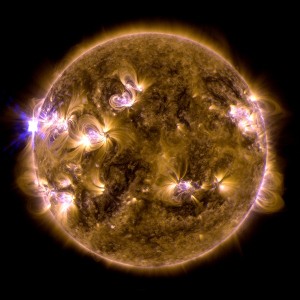Sun unleashes 3 potent solar flares

This blend of two images taken by NASA’s Solar Dynamics Observatory shows a solar eruption that occurred on May 12, 2013. The Sun has unleashed three potent solar flares in just under 24 hours, marking the most intense activity yet this year and causing limited interruptions to high-frequency radio communications. more strong solar flares may be expected in the coming days. AP PHOTO/NASA’S SOLAR DYNAMICS OBSERVATORY
WASHINGTON—The Sun has unleashed three potent solar flares in just under 24 hours, marking the most intense activity yet this year and causing limited interruptions to high-frequency radio communications.
One of them was classified as an X3.2 flare, with X-class flares being the most intense type, the US space agency said.
“This is the strongest X-class flare of 2013 so far, surpassing in strength the two X-class flares that occurred earlier in the 24-hour period,” NASA said of the latest flare that peaked at 0111 GMT Tuesday.
The flares have sent off bursts of radiation from the Sun, known as coronal mass ejections (CMEs). The most recent traveled particularly fast, at a speed of approximately 1,400 miles (2,253 kilometers) per second, NASA said.
NASA said the CMEs would produce a merged cloud of solar material that “may give a glancing blow to the STEREO-B and Epoxi spacecraft,” which are space-based observatories orbiting Earth to monitor solar storms and comets.
“Their mission operators have been notified. If warranted, operators can put spacecraft into safe mode to protect the instruments from solar material,” the US space agency said.
Experts say that a rise in solar activity is common right now because the Sun is in a phase of its 11-year activity cycle that is nearing the solar maximum, expected in 2013.
According to space weather experts at the National Oceanic and Atmospheric Administration, more strong solar flares may be expected in the coming days.
Although CMEs send off potent radiation, Earth is protected by its magnetic field.
Solar activity can temporarily disrupt GPS signals and communications satellites, but most people will not notice any effects in their daily lives.
The first X-class flare of this solar cycle occurred in February, 2011. The largest so far of the current cycle was documented as an X6.9 in August 2011.














